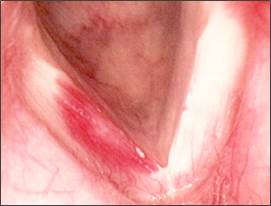Symptoms & Disorders
Common Voice Disorders
Vocal Fold Nodes or Nodules– Vocal fold nodules are calluses of the vocal cords and are generally due to some form of trauma. The most common cause is voice overuse and misuse. In children they are often called “screamer nodes.” Symptoms include hoarseness, rough voice, and tiring of the voice. Typically speech/voice therapy is the treatment of choice. Any exacerbating underlying medical conditions must also be treated.

Vocal Fold Polyps/Reinke’s Edema– Polyps are typically fluid filled lesions on the vocal fold. While nodules are typically bilaterally, polyps are often on one vocal fold. Unlike polyps elsewhere, they are not associated with cancer. They interrupt vocal fold closure and change the sound of the voice. Reinke’s edema is a clinical term used to describe a common form of chronic laryngitis, wherein the entire covering of the vocal cords becomes polypoid and swollen. The condition is most often associated with irritation from tobacco smoke and/or alcohol. The treatment is usually surgical excision, although occasionally a small polyp may respond to voice therapy. It is essential that the underlying irritating condition be treated or stopped, or the chronic laryngitis will return.
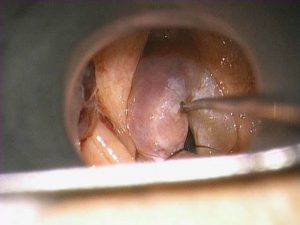
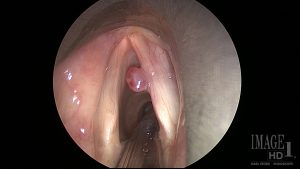
Vocal Fold Cysts– A cyst is a mucus or skin filled sac which interrupts the vibration of the vocal fold. The exact cause of vocal cord cysts is unknown. They may be congenital or may result from voice overuse. In this case, the pathology is just under the surface of the vocal cord and encapsulated. Microlaryngeal surgery is often used to remove the cyst from the vocal cord while keeping trauma to the overlying surface of the vocal cord at a minimum. Vocal cysts can recur.
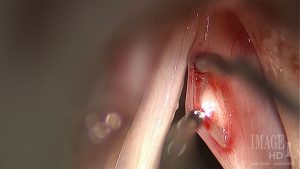
Vocal Fold Paralysis– This refers to immobility of one or both vocal folds (Injury almost always occurs unilaterally, not bilaterally). The first step in treating vocal fold paralysis is trying to ascertain the cause. Vocal fold paralysis can result from surgical procedures of the brain, neck , or chest, or a mass in the neck or chest. This usually requires imaging studies of the neck and chest. In some cases a cause is never found. Such cases are usually attributed to a viral infection of some sort. A variety of treatments exist depending on the severity of the paralysis. Two nerves innervate each side of the larynx and any combination of the four nerves may be involved. Sometimes special testing known as laryngeal electromyography (EMG) may be used to define which, if any nerves are involved and what the prognosis for recovery is. Treatments range from voice therapy to strengthen the remaining innervated muscles, to injection of substances into the paralyzed vocal cord, to a variety of operations designed to either push or pull the paralyzed vocal cord back to a more normal position for improved speech or to reinnervate the damaged nerve.
Reflux Laryngitis– Irritation of the larynx from stomach contents, which reflux back up into the throat. This is often referred to as laryngopharyngeal reflux or LPR. Symptoms include hoarseness, throat clearing, “lump in the throat” sensation, cough, and/or increased phlegm. Sometimes patients are unaware of the actual reflux and may have no obvious clinical symptoms. Treatment is aimed at stopping the reflux. The mainstay of treatment is often lifestyle changes including, but not limited to, avoidance of alcohol and tobacco, weight loss, changing dietary habits, and sleeping with the head of the bed elevated. A variety of medications exist to change the quality of stomach secretions. Sometimes special testing such as a 24 hour pH probe study, esophagogram, esophagoscopy, or esophageal manometry are necessary to fully evaluate this condition.
Spasmodic Dysphonia or Focal Laryngeal Dystonia– A neurologic disorder in which control of laryngeal function is altered. The vocal fold muscles spasm and cause interruptions in the voice. By far the most common variety is adductor laryngeal dystonia in which vocal cords shut prematurely and too forcefully during phonation leading to a strained or strangled quality to the voice. An abductor variety also exists in which the voice is excessively breathy. Spasmodic dysphonia often also has a component of tremor associated with the actual spasms. The mainstay of treatment is speech/voice therapy and Botulinum Toxin injections.
Laryngeal Papilloma– Recurrent respiratory papillomatosis is as disease casued by the Human Papilloma Virus (HPV). Wart-like lesions grow in the respiratory tract and can affect the voice and breathing. The condition tends to be more pronounced in children, though adults can be affected as well. Rarely, the condition can spread to involve the trachea and lungs. Although a variety of antiviral medications have been tried in this condition, none have achieved widespread acceptance. Many people are infected with the HPV virus, but only some exhibit papillomas. The mainstay of treatment is surgical removal. A variety of techniques may be used including operating room or office based excision and/or laser ablation. The technique is chosen on an individual basis. The procedure usually must be repeated when the lesions recur, as treatment is not curative.
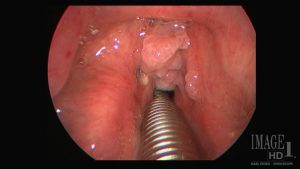
Vocal fold atrophy/Aging Voice– Sometimes with age, simple muscular atrophy of the vocal cords results in bowing of the folds. Thinner vocal folds can cause a weak, tired voice that is hard to be heard in loud or noisy environments. Partial paralysis or weakness of a vocal cord may also give it a bowed appearance. Treatment usually begins with speech/voice therapy to strengthen the vocal fold muscles. The vocal cords may also be augmented with an injection of a substance or medialized (pushed closed) with an implant.
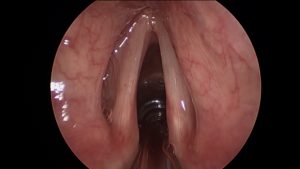
Vocal fold scar/sulcus vocalis– This is often the result of vocal misuse/overuse or trauma to the vocal folds. The voice is often strained or breathy. Treatment is difficult and is individualized. A variety of options may be employed including speech/voice therapy, microlaryngeal surgery, injection augmentation, or medialization with an implant.
Muscle Tension Dysphonia– Involuntary and inappropriate vocal use by the patient. In general, the muscles of phonation, i.e. the vocal folds, are being overused. The extrinsic musculature around the larynx and at the front of the neck may also feel tight and sore. The condition may develop as a maladaptive compensation for some other vocal pathology, or irritant such as gastroesophageal reflux. Occasionally, muscle tension dysphonia may develop in an attempt to use a hoarse, weak voice during or following an upper respiratory infection. Voice therapy is usually the treatment of choice coupled with identification of any underlying medical condition that may be exacerbating the problem.
Vocal Fold Granuloma- is an inflammatory growth. It typically occurs on the back portion of the vocal fold. Causes include vocal overuse/misuse, intubation of the larynx during surgery for some other condition, or maladaptive response to underlying voice condition. It can be exascerbated by gastroesophageal reflux, which further irritates the area and prevents proper healing. Treatment can be quite difficult and frustrating. Speech therapy, voice rest, steroids, antireflux therapy, and antibiotics can sometimes clear up granulomas after a period of time. Sometimes microlaryngeal surgery is necessary to remove the lesion and to inject the lesion with steroids. This is often used in conjunction with the above medical management.

Laryngeal Cancer– Cancer of the voice box. The major risk factors are tobacco and alcohol use. The most common warning signs of laryngeal cancer are voice change, painful or difficult swallowing, coughing up of blood, neck mass, and/or ear pain. Treatment options are surgery or radiation therapy, or a combination of the two. Chemotherapy may be added in advanced cases. When detected early, most laryngeal cancer can be cured with preservation of the larynx. For patients with advanced cancers that require a laryngectomy (removal of the voice box), excellent techniques for voice rehabilitation exist.

Laryngeal Trauma– The result of a blunt, penetrating object, hitting a steering wheel during a motor vehicle accident, or iatrogenic (the result of other medical interventions such as intubation). The aims of treatment are to maintain and restore a normal airway and voice.
Vocal Fold Hemorrhage and Vascular Lesions– May occur as the result of acute injury such as screaming, coughing or other trauma. Some vascular lesions may be connected with hormonal changes such as occur during the menstrual cycle. Treatment is usually voice rest and steroids. Speech therapy or microlaryngeal surgery is used in some cases.
